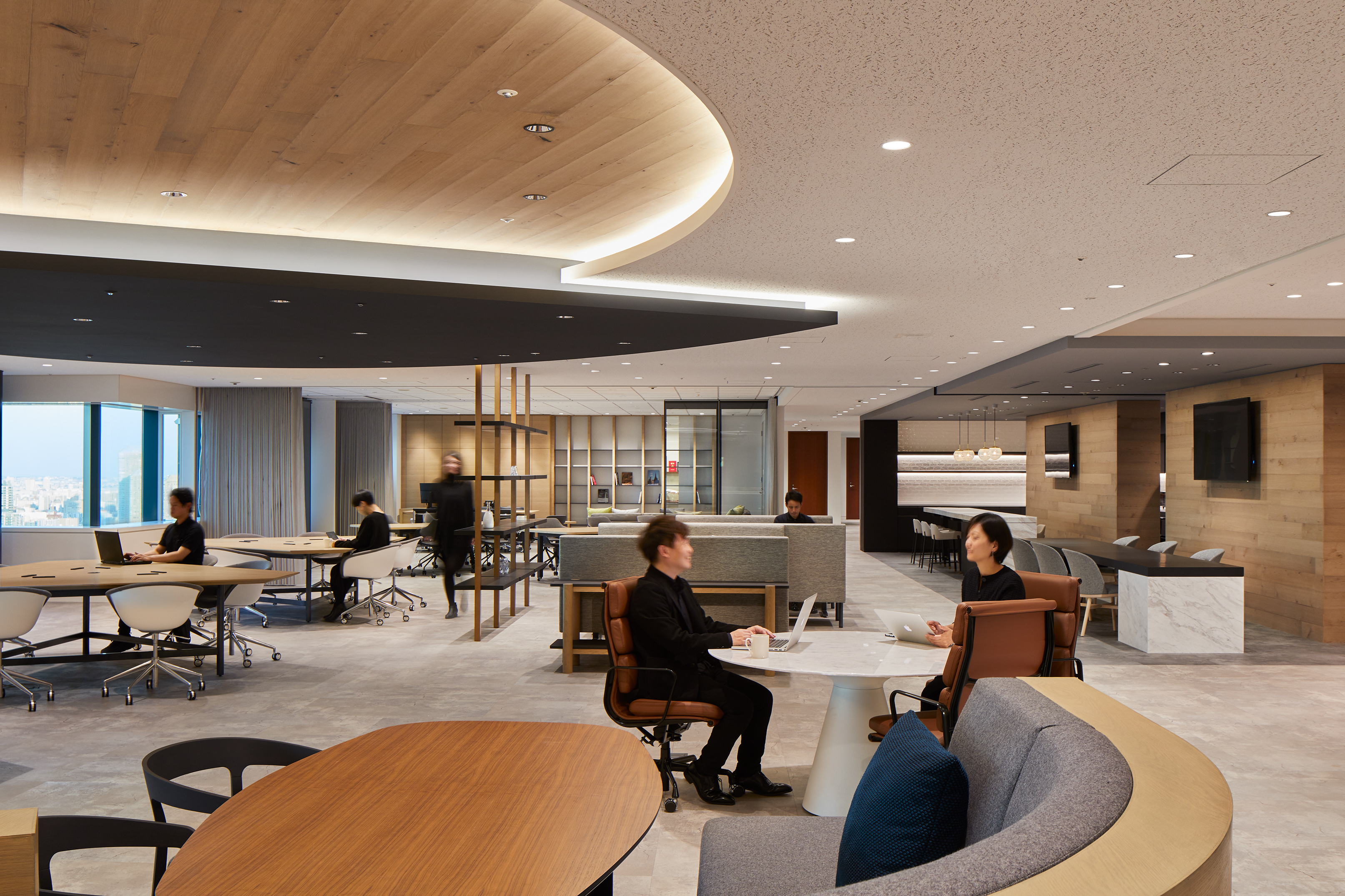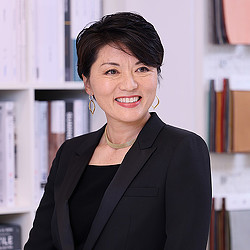How Workplaces in Tokyo Are Embracing Flexible Work
フレキシブルな働き方を促す東京のワークプレイス事情
May 15, 2024 | By Chinatsu Kaneko
2024年5月15日 | By Chinatsu Kaneko
Editor’s Note: This article was originally published in September 2023. It has been updated throughout to reflect current trends and conditions as of May 2024.
Tokyo is embracing flexible work to support a diverse workforce and companies are taking careful steps to design workplaces that meet modern expectations as workers seek a fulfilling work-life balance. Since the start of 2017’s Japanese government-driven Work Style Transformation mandate, companies have become more modernized to address some of the challenges the country is facing, such as labor shortages, an aging population, the need to increase birth rates, employee well-being, and gender equality and diversity in the workplace.
Flexible work allows for different work styles and creates accessibility that supports a diverse workforce. The inclusive workplace creates a sense of trust and support for employees that increases productivity and retention, while also offering an environment that empowers employees to do their best work.
In late 2023 and early 2024, we started to see a shift in the way companies are addressing work policies. There are those that encourage employees to spend more time in the office for more vibrant engagement, collaboration, and innovation. There are others that have embraced remote work to bring in talent regardless of location and to support diverse work styles. Both continue to operate with a flexible work style that supports the employee’s individual needs and preferences, but the emphasis on the best performing workstyle differs from one to another. Companies who piloted different work styles and ideas over the last few years have more information and insights from which they can make educated decisions regarding their longer-term commitments to their improved workplaces.
Recurring Themes in Today’s Workplace
Gensler’s most recent Global Workplace Survey report found that employees spend equal amount of time (40%) doing individual work as they do workinbg with others (40%), either in-person or virtual collaboration. In general, people seem to be collaborating more.
When it comes to designing high-performing workplaces for hybrid environments, we are seeing similar trends emerging in Tokyo, including:
- Collaboration and knowledge sharing, both formally and informally, can be found in learning centers, multi-purpose event and collaboration spaces, and large staircases that connect all floors with surrounding communication spaces. Gensler transformed the Fujitsu executive floor to create a more communicative environment for staff and executives. The workplace reinvented the executive space as a useful and approachable environment for all Fujitsu staff.
- Focus space for concentrated work and private conversations as employees seek environments that support concentration.
- Wellness through amenities and by creating a healthier environment with access to natural light, and a range of food options in the employee café.
- Strengthening people’s sense of belonging to the culture and mission of the brand with branded interior design that goes beyond putting corporate mission on the wall, and digital touchpoints throughout the workplace. Shiseido's Tokyo office is an early example that embodies the global beauty company’s new vision — Work x Life x Beauty — through the creation of an immersive workplace where people can experience Shiseido’s values and mission come to life, providing a great example of the power of collaboration with ample dynamic working environments that encourage employees to interact and exchange ideas.
- Working in tandem with coworkers both in-person and virtually requires improved technology, training on leading hybrid meetings, and better spaces to execute different types of hybrid work.

Empowering Change Through Collaborative Pilots and Adaptation
In Tokyo, our collaborative approach to pilot projects is a differentiator. Our clients are empowered to make informed decisions about their future work dynamics while finding thoughtful responses to a diverse array of questions such as: How do employees best collaborate with one another? What are the technologies and tools we need in these spaces? How are these spaces supporting neurodivergent and disabled employees?
By piloting new space types, we can test ideas, collect user feedback, and continuously improve the design. The critical component in successfully executing pilots is to set the right parameters and evaluation criteria. For example, a digital transformation consulting client tested a variety of spaces and decided that teamwork was most valuable to them. Our final design kept the office configuration that best supported that outcome.
Piloting engages stakeholders and end-users in the final decision-making for workplace design. It also fosters dialogue among employees about how to improve their work style for the future. Similarly, we see executives asking deep questions about performance evaluation, employee well-being, how they are creating value and innovation, and defining what offices are for in their own way.
While we know many workers want to be in the office, these workplaces must be destinations that support a variety of work styles and a range of employee priorities like mobility, choice, privacy, and working with others virtually. The future of hybrid work in Tokyo and beyond hinges on creating inclusive workplaces where employees can be empowered to be their best.
For media inquiries, email .
編集部注:この記事は2023年9月に英語で掲載されたものの日本語版です。2024年5月現在のトレンドと状況を反映するため、全体的に更新されています。
東京では多様な労働力をサポートするためにフレキシブルワークの促進が続いている。充実したワークライフバランスを求める価値観が定着する中、企業は現代の期待に応えるワークプレイスデザインを求め慎重な措置を講じ続ける。2017年に内閣官房が設置した働き方改革推進会議を皮切りに、企業は日本が直面している課題解決に向けた働き方の近代化を求められているからだ。少子高齢化に従う生産年齢人口の減少、出生率向上の必要性、従業員の福利厚生の充実化、職場における男女平等と多様性など、これらの側面に対して企業はフレキシブルワークの導入とワークプレイスデザインの改革を継続する。フレキシブルワークは、様々なワークスタイルを可能にすることで多様な労働力を支える。多様性を大切にするインクルーシブな職場は、生産性と定着率を高めると同時に、ワーカーの信頼感や帰属意識を生み出し、高いパフォーマンスを発揮する環境になり得る。
2023年後半から2024年初頭にかけ、働き方のルールに対する変化が見られ始めた。より活気あるエンゲージメント、コラボレーション、イノベーションを実現するために、ワーカーがオフィスで過ごす時間を増やすことを奨励する企業が増えた。一方で、所在地に関係なく人材を集めるためにリモートワークの活用を高める企業も増えた。どちらも個人のニーズや事情に応える働き方の柔軟性を継続している。しかし、最高のパフォーマンスを発揮する場に対する考えは異なり始めている。さらに、ここ数年、数々の働き方を試験的に試してきた企業は多くの情報や洞察を得ており、そこからワークプレイス改善への中長期的な判断を下し始めた企業があるようだ。
昨今のワークプレイスで繰り返されるテーマ
ゲンスラーの最新の グローバルワークプレイス調査レポート は興味深い結果となったので、ぜひ全レポートをご一読頂きたい。それによるとワーカーが個人で仕事をする時間(40%)とチームと一緒に仕事をする時間(40%)が同じであり、対面またはバーチャルのコラボレーションに以前より時間を費やしていることが世界共通して分かった。チームでのコラボレーション活動が一般的に増えているといえる。
また、東京のフレキシブルワーク環境におけるパフォーマンスの高いワークプレイスデザインの傾向は世界のトレンドと共通している部分が多い。ここでいくつか例を挙げてみよう。
- コラボレーションと知識共有活動の場は、フォーマルにもインフォーマルにも、多目的イベントスペースや多種多様なコラボレーションスペースが好まれる。大型物件ではフロアと周囲のコミュニケーションスペースをつなぐ内部階段がインパクトを生む。我々は 富士通社 のエグゼクティブフロアデザインを手がけた際に、社員とエグゼクティブがコミュニケーショ ンを取りやすい環境作りを目指した。富士通の全スタッフにとって便利で親しみやすいエグゼクティブエリアに生まれ変わる提案を実現頂いた。
- オフィスでの集中作業のニーズは定着しており、フォーカススペースの多様化も今後は期待される。
- 自然光を最大限取り込む環境や社内カフェでの健康的な食事メニューなど、より健康的な環境やアメニティを整えることでウェルネスの実現に繋げる取り組みは継続されている。
- ブランド化されたインテリアデザインやデジタル・タッチポイントによって、企業の文化やミッションを伝え続け帰属意識を高め続けることが重要視されている。例えば、資生堂 の東京オフィスは新しいビジョンを体現化させた事例である。イマーシブワークプレイスづくりを通じて、グローバルなビューティーカンパニーである資生堂の新しいビジョン「Work x Life x Beauty」を具現化した例であり、ワーカー同士の交流やアイデアの交換を促すダイナミックな環境を充実させることで帰属意識を高めるワークプレイスとなった。
- 対面でもバーチャルでもチームワークを行うには、テクノロジーの向上、ハイブリッドミーティングをリードするためのトレーニング、さまざまなタイプのハイブリッドワークを実行するためのより良いスペースが求められている。

パイロット・プロジェクトを通じて変化を促す
ゲンスラー東京は、ここ数年数々のクライアントとパイロット・プロジェクトに取り組み新しいワークプレイスの要素を試作してきた。テストスペースを作り従業員のニーズに合わせて調整することで、クライアントは新しい働き方へ一歩ずつ移行している。パイロットではコラボレーションの仕方や必要なテクノロジーやツールを模索するだけでなく、どのようにニューロダイバシティや障がいのあるワーカーをサポート出来るかなども考える。
新しいスペースタイプのアイデアをテストし、ユーザーからの フィードバックを 集 め 、デ ザ イ ン の改善を継続する 。パイロットに重要なことは、適切なパラメータと評価基準を設定すること。例えば、あるデジタルトランスフォーメー ションコンサルティングのクライアントはさまざまなスペー スをテストし、チームワークが最も重要であると判断した。私たちの最終的なデザインはその結果を最 もサポートするオフィス構成となった。
パイロット・プロジェクトの更なる良さはワークプレイスデザインの最終的な意思決定にステークホルダーやエンドユーザーを巻き込めること。実験的な検証プロセスはワーカー同士の対話を促進しワークスタイルの改善にもつながる。またエグゼクティブ達がワークプレイスと働き方の強い関係性に気づいている様子が伺える。組織文化やパフォーマンス評価、イノベーション創造に繋がる環境、そしてオフィスの価値を自分たちなりに定義しながら、今後のフレキシブルワークの方針を生み出し始めている。
高いパフォーマンス発揮のためにオフィスを活用することを多くのワーカーが望む一方で、ワークプレイスは多様なワークスタイルやモビリティ、アジリティ、フレキシビリティといったワーカーの優先事項をサポートする場所でありたい。東京のフレキシブルワークの未来は、ワーカーが生き生きと働ける包括的なワークプレイスを創造することにかかっている。
For media inquiries, email .
_1692988207_1024x576.jpg)
